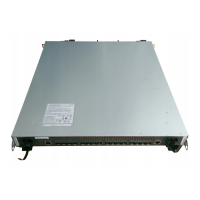444 Port-Channel/LAG (802.3ad) Commands
Port-Channel/LAG (802.3ad) Commands
This section describes the commands you use to configure port-channels, which
is defined in the 802.3ad specification, and that are also known as link
aggregation groups (LAGs). Link aggregation allows you to combine multiple
full-duplex Ethernet links into a single logical link. Network devices treat the
aggregation as if it were a single link, which increases fault tolerance and
provides load sharing. The LAG feature initially load shares traffic based upon
the source and destination MAC address. Assign the port-channel (LAG) VLAN
membership after you create a port-channel. If you do not assign VLAN
membership, the port-channel might become a member of the management
VLAN which can result in learning and switching issues.
A port-channel (LAG) interface can be either static or dynamic, but not both. All
members of a port channel must participate in the same protocols.) A static port-
channel interface does not require a partner system to be able to aggregate its
member ports.
If you configure the maximum number of supported dynamic port-channels
(LAGs), additional port-channels that you configure are automatically static.
port-channel This command configures a new port-channel (LAG) and generates a logical
slot/port number for the port-channel. The
name
field is a character string which
allows the dash “-” character as well as alphanumeric characters. Use the
show
port channel
command to display the slot/port number for the logical interface.
Instead of slot/port,
lag
lag-intf-num
can be used as an alternate way to
specify the LAG interface.
lag
lag-intf-num
can also be used to specify the
LAG interface where
lag-intf-num
is the LAG port number.
Before you include a port in a port-channel, set the port physical mode. For more
information, see “speed” on page 312.
Format
port-channel
name
Mode Global Config

